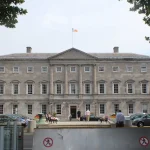After a summer loosening of covid restrictions Prime Minister Boris Johnson first tried to control the virus spread with temporary and differing regional lockdowns.
But mayors and other politicians in the Manchester and Liverpool areas of England’s northwest claimed unfair and unequal treatment by the central government and perhaps even more damaging to any sense of fairness and trust was his government’s refusal to continue free school meals to the country’s neediest children in the half-term school holiday despite a widely supported campaign started by English football star Marcus Rashford.
So on September 24 Johnson moved away from opening up and announced new restrictions. He promised stricter enforcement as cases rose, more people were admitted to hospital, and the reproduction rate of infection increased. And the UK’s finance minister Rishi Sunak extended and revised financial support for workers and businesses that was due to end in October.
Johnson faced growing pressures inside his Conservative party over both restrictions and the arbitrary use of emergency powers without Parliamentary scrutiny – as well as disquiet about breaching international law over Brexit that also prompted high profile human rights lawyer Amal Clooney to resign as the UK’s special envoy on media freedom.
The Johnson government tried to balance conflicting pressures but public opinion favoured stronger measures as the resurgence of the coronavirus proved a blow to hopes for an emergence from lockdown and a quick economic recovery – hopes that had taken shape stutteringly and slowly only a few weeks earlier.
Most schools had reopened and students returned in the first week of September – with a few reports of problems and despite much debate and concern about both safety and education. And there were also glimmers of a return to work.
The Johnson government had been beset by a series of mistakes and embarrassing policy u-turns in the first six months of the pandemic that eroded trust, virtually erased his party’s lead in public opinion polling and even dropped his approval rating below Opposition leader Keir Starmer’s in some polls.
Probably the biggest break in public trust came in late May after the Guardian and Daily Mirror newspapers revealed that Johnson’s key adviser Dominic Cummings broke the government’s own lockdown rules – a revelation that prompted a clamour for his dismissal and calamitous poll numbers for the prime minister. But Cummings was so important to Johnson that he refused to drop him, mounted a robust defence, and managed to keep Cummings in his job – but not stifle the criticism.
Cummings and a key ally were forced out of Johnson’s office in November in a power struggle with Johnson’s new partner, Carrie Symonds.
Unfair treatment in Manchester and Liverpool
Free school meals
New restrictions
Revised financial support
Pressure from Tory MPs
Disquiet about breaking Brexit law
Amal Clooney resigns
Balancing conflicting pressures
Public wants stronger measures
Return to school
Concerns about school return
Return to work?
Policy U-turns
Tory lead cut
Political approval ratings
Poll shows Tory lead erased
Cummings breaks lockdown rules
Clamour for dismissal
Calamitous poll numbers







